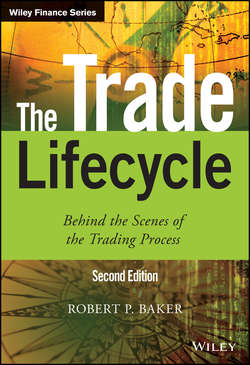Читать книгу The Trade Lifecycle - Baker Robert P. - Страница 22
На сайте Литреса книга снята с продажи.
Part One
Products and the Background to Trading
Chapter 3
Understanding Traded Products – Follow the Money
ОглавлениеTo gain an understanding of financial trading one must distinguish between the concept of an asset class and that of a financial product. These terms are often confused. The aim of this chapter is to define a set of common financial products. In the following chapter we discuss asset classes. A financial product (or ‘product’) is a contract between two parties which determines an exchange of money or assets. There are many specific products tailored for the needs of one or both parties, but here we will discuss a set of common products existing in the financial world with a well-defined structure.
To help remove the confusion between products and asset classes, let us consider the everyday case of buying a sack of potatoes and the less frequent purchase of a washing machine. Essentially the process of acquisition of potatoes and washing machines is the same: you spend money and receive goods. However, since the type of vendor, the layout of the store, the delivery mechanism and various other factors are different, we normally view these two acquisitions in different ways. We may say that potatoes are in the asset class of perishable food and washing machines are in the asset class of domestic appliances. So the underlying process is the same but the asset classes are different.
The same is true for financial products. Buying shares is intrinsically the same as buying aluminium, sovereign bonds or purchasing dollars in exchange for euros. However, since the people and trading environments of each of these trades are very different, we generally group them into different asset classes. (The examples above corresponding to equities, commodity, fixed income and foreign exchange (FX)). The processes for dealing with each of these trades will normally depend on the asset class rather than the product itself.
As we have seen, some products exist in more than one asset class. Every asset class has a suite of possible products. A financial institution organises its traders, sales staff, middle office and controllers around each asset class rather than around each product.
A trade is an actual instance of a product. There are two parties to any trade, often referred to as counterparties or counterparts. Many products make reference to other parties or events. For example, UBS might buy Ford Motor Company shares from BNP Paribas. The two parties to the trade are UBS and BNP Paribas. Once purchased, UBS will have to claim dividends from Ford and not from BNP Paribas, so UBS will have to make Ford aware of its acquisition.
Some products make reference to events or entities. A swap trade (described below) needs at least one reference entity for its float leg (or two for a float-float swap). The reference will state the date, time and nature of the entity to be taken into consideration. An analogy might be to betting on a horse. The customer purchases the bet from the seller (the bookkeeper) but any winnings are dependent on the reference entity in the bet (the horse and the race). The horse itself knows nothing of the trade.
As mentioned, financial products are contracts. We can analyse the product by looking at the terms and conditions of the contract, but it is often easier to examine the cash or asset flows. The product is uniquely defined by the following:
■ date
■ value
■ direction
■ type of cashflow (cash or physical).
The cashflows are the mechanics of how the trade works from start to finish. The value of the trade is something different. Value is a function of the expected worth of future cashflows. Note the keywords expected and future – these involve a view of how the underlying market forces will change over time. So do not confuse cashflows, which are determined at the start of the trade by the type of product being traded, with value which varies over the lifetime of the trade.
For a consistent approach, let us consider each product from our point of view as a trader who is buying something. We shall use the following graphical notation:
■ A down arrow indicates something we are contractually obliged to part with.
■ An up arrow indicates something we are contractually expecting to receive.
■ A grey arrow indicates money (cash) in our own currency.
■ A black arrow indicates something other than money or cash in a foreign currency.
■ A straight line indicates a fixed amount.
■ A dotted line indicates an unknown amount.
